One of the most popular materials for finishing the roofs of private houses is shingles. It is a plate obtained by processing wood chocks. Coniferous wood is used for the manufacture, including pine, larch, spruce. These varieties contain an increased amount of resin, which provides natural protection against decay, mildew and mildew. Modern manufacturers offer a wide range of sizes and design options for roof shingles, so you can choose products for almost any facade. This roof covering looks best on houses decorated in German, Scandinavian, Russian style.
The difference between shingles and shingles
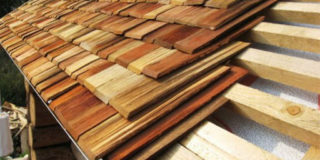
These materials have a similar structure, but they have a number of differences. Shingles are wood plates of small thickness, cut from the block in the longitudinal direction. The roof with such a coating is installed in 4-8 layers. The standard length of one element can vary within 40-100 cm, width - 9-13 cm, thickness does not exceed 5 mm.
Shingle roofing material is wedge-shaped planks, the length of which is 40-60 cm, and the width is up to 14 cm. On the thickened edge there is a 12 mm groove for installation. During processing, the raw materials are sawn longitudinally, which allows you to maintain decent strength and ensure a long service life of the finished coating.
Varieties of shingles for the roof
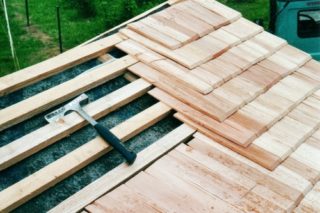
The main classification of this material is possible according to the method of processing the raw material. There are two types - chipped and sawn products.
Chipped
This variety is made by hand, the finished parts are characterized by increased durability, aesthetic appearance and reliability. The service life of chipped shingles exceeds 50 years, provided that the installation requirements are met. The coating is used for finishing roofs and facade works. However, such material has a significant disadvantage: the price can be almost double the cost of another type. You can save on the purchase if you make shingles for the facade with your own hands.
Sawn
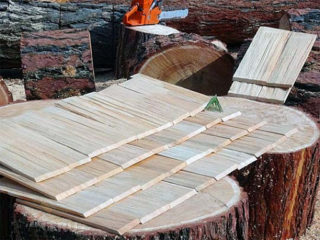
This variety is obtained by processing on an industrial machine, sawing the workpieces along the fibers. The technology makes it possible to produce a relatively inexpensive, practical material, while retaining the structure and design of natural wood. The main advantage is the reduced price, due to which you can save on the arrangement of the coating.
Sawed shingles for roofing have an ideal geometry, smooth and pleasant to the touch surface, ease of installation. However, the products have a small drawback: the service life does not exceed 30-40 years, roof repairs will be required earlier. Durability can be improved by treating the surface with protective compounds, but this increases the cost of the structure.
Material advantages
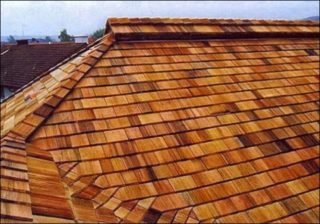
Both roofing shingles and shingles have many positive properties:
- complete tightness of the finished surface due to the multilayer structure;
- increased resistance to wind loads, including hurricane gusts, precipitation, debris;
- resistance to burnout, sharp thermal fluctuations;
- antistatic properties;
- attractive appearance, emphasizing the wealth and sense of taste of the owner;
- a huge variety of color options and textures, which allows you to choose the perfect solution for every taste;
- the possibility of installing a shingle roof with slopes located at an angle of 18 to 90 degrees;
- operational and relatively simple installation, possible regardless of weather conditions and time of year;
- excellent sound absorption performance;
- an environmentally friendly composition that allows you to create a favorable microclimate under the roof, which is especially important when constructing an attic floor;
- no need to place an additional layer of material for vapor barrier under the coating;
- when impregnated with antifungal agents and protective compounds, resistance to mold, parasites and rodents increases.
Compatibility with most classic facade styles and almost any building configuration allows you to use the material for finishing the roof of a private house, summer cottage, sauna, outbuildings, regardless of the number of storeys and sizes.
Dimensions of the structure
On sale you can find a variety of products that differ in the size of the slats. You can see the ratio of dimensions in the table:
| Length, mm | Width, mm | Thickness, mm |
| 200 | 60-100 | 6-7 |
| 400 | 60-200 | 9-10 |
| 500 | 60-200 | 9-10 |
| 600 | 80-250 | 10-15 |
| 800 | 80-250 | 10-15 |
Making and laying shingles for the roof with your own hands

To save money, you can make the required amount of material on the roof of the house yourself; this is a good solution if the owner chooses a sawn variety. It is not necessary to buy a professional machine for this: such an acquisition is unlikely to be profitable. You can build equipment with your own hands by placing a number of discs for wood processing in a metal box. Raw materials are loaded into the container from above. It is necessary to use boards that do not have surface defects and foci of rot.
The shingle roof is assembled in stages. Basic actions:
- Harvesting chocks. If you use logs, you will need to remove the bark, cut out the central part, and then cut the chocks into identical plates.
- Installation of the rafter frame. A film for waterproofing is attached to it, using a special construction stapler for fixing.
- Fastening the lathing. It is nailed or drilled with wood screws on top of the waterproofing. To create a lattice, an edged board with a thickness of 3-5 mm or blocks is required.
- Stacking chocks. It is required to start from the bottom row, the boards are fixed with special 60 mm nails treated with linseed oil.
The second row is overlapped so that the seams are closed from external influences.
Shingle imitation materials
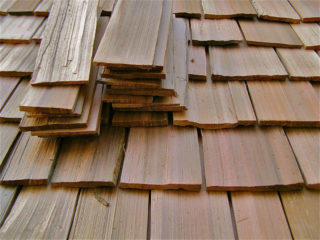
Building materials are on sale that look similar to their natural counterpart, but have a different composition:
- copper shingle, which is a metal profile with a verified geometry and in the form of squares, rhombuses or scales;
- plastic siding with imitation of a wooden surface, combining moisture resistance with low weight;
- polymer artificial shingles, in quality almost corresponding to the original, but containing toxic components in the composition.
The finished roof made of natural shingles looks aesthetically pleasing, solid and harmonious with the facade. If you need to save money, you can purchase materials that mimic the appearance of such a coating, but their performance is usually not so good.








